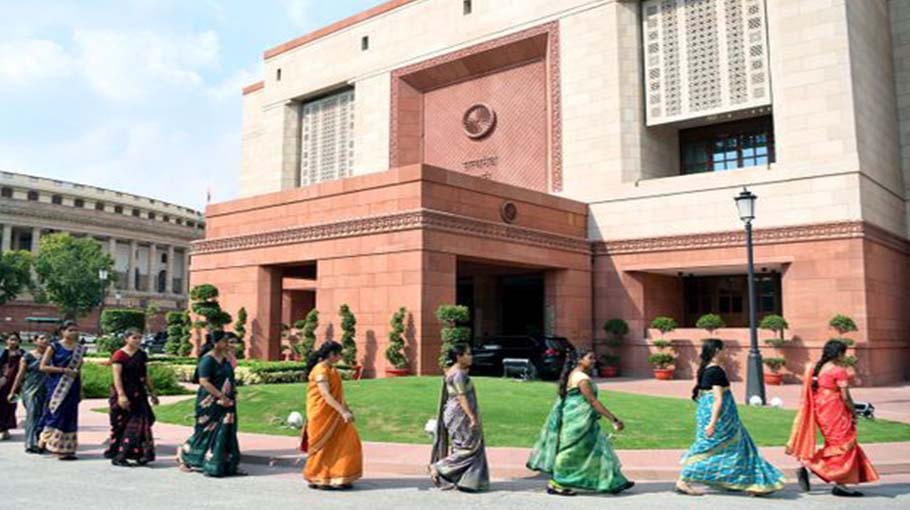The Women’s Reservation Bill is Modi’s gift to India
Bill that reserves a third of seats in parliament and assemblies was pending for 30 years


Usually, it is the birthday boy who gets the surprise party. In Indian Prime Minister Narendra Modi’s case, however, it is his “return gift” to the nation that kept everyone guessing. Speculation was rife over what was the special surprise package that the ruling Bharatiya Janata Party (BJP), led by Modi, intended to introduce. That too in the special, very short, five-day session of the Indian Parliament starting September 18, the day after the prime minister’s 70th birthday. Turns out, it is the Women’s Reservation Bill to secure 33 per cent of the seats in the Lok Sabha (lower house) and the state assemblies for women.
Modi called September 19 a historic day, exhorting the Opposition to support the bill so that it might pass unanimously (It was passed in the Lok Sabha on Wednesday with 454 lawmakers voting for and two against). The bill, dubbed Nari Shakti Vandan Adhiniyam, or a bill that honours women’s empowerment, has been pending for almost 30 years. It was first introduced in 1996 by prime minister Deve Gowda of the United Front. It lapsed after failing to win the approval of the House and the 11th Lok Sabha was dissolved in 1998.
After the general elections that year, the 12th prime minister of India, Atal Bihari Vajpayee, reintroduced the bill. Again, it failed to pass. Reintroduced again in 1999, 2002, and 2003, the bill could not win enough votes. Prime Minister Manmohan Singh of the Congress, yet another time, proposed the Women’s Reservation Bill in 2008, tabling it in the upper house or Rajya Sabha of the Indian Parliament. Here, it was cleared in 2010. But it was never taken up in the Lok Sabha, or the lower house, for consideration. It lapsed with the dissolution of the 15th Lok Sabha in 2014.
Modi’s masterstroke for women-led development
Now, bringing this long-pending bill back into the reckoning, that too as the first order of business in the brand-new Parliament building, inaugurated on the auspicious occasion of Ganesh Chaturthi, is clearly Modi’s masterstroke. He was sending out a message to the nation. “On this historic occasion in the new Parliament building, as the first proceeding of the House, the beginning of all the Parliamentarians opening gateways for women power is being done with this crucial decision.” It was, he added, “our resolve of women-led development.”
If 33 per cent of seats are occupied by women
parliamentarians, some of the most backward
regions of the country, where women’s empowerment
is most needed, will benefit enormously. The time for
a 33 per cent quota in Indian politics has arrived
What better way to further India’s democratic traditions? Law Minister Arjun Ram Meghwal, who tabled the bill in the Lok Sabha, said: “We want more and more women to join the development process of the country.” Though women constitute nearly 50 per cent of India’s close to a billion registered voters, they make up only 15 per cent of elected parliamentarians in the Lok Sabha. Regarding the state assemblies, the figure, around 10 per cent, is even lower. The bill will add almost a 100 more women lawmakers to the present number of 82 out of 545 seats in the lower house of the Parliament.
The main opposition party, the Congress, has started taking credit for the bill. Adhir Ranjan Chowdhury, leader of the party in the Lok Sabha, said: “Former Congress governments under Rajiv Gandhi, PV Narasimha Rao, and Manmohan Singh had consistently tried to pass the bill to provide reservation for women.” Senior Congress leader Sonia Gandhi was also reported as saying, “This is our bill.” Therefore, the support of the Congress in its passage was guaranteed. Women lead the other parties such as the All India Trinamool Congress. Aam Aadmi Party, which is in power in Delhi and Punjab, and some bigger regional parties like the Biju Janata Dal and the Left parties also lent support.
Some of the salient features of the bill include one-third reservation for women within the reserved seatsfor Schedule Castes/Schedule Tribes (SC/ST). This will foster greater gender representation and equality within the backward sections of society. The increase in women elected representatives is expected to bring a sea change in Indian politics. For one, it is hoped that with more women candidates in the fray, the harsher aspects of the system, including the domination of muscle power and money, will be reduced. As will criminal elements and what may be termed more loosely as “indecency” — unruly behaviour and language both on the streets and inside the house. There may be greater rewards, such as greater fiscal prudence and more compassionate governance.
On September 18, as Modi bid farewell to the historic parliament building, which was a colonial legacy, rumours were rampant as to the purpose of the special session of parliament. But the cabinet meeting later that evening, laid some of the Opposition’s fears and suspicions to rest. The new parliament building has 888 seats for the Lok Sabha. The census delimitation exercise, expected to commence in 2026, is likely to increase the number of members of the parliament to 848 if the current rates of population increase continue.
If so, more seats will go to states such as Uttar Pradesh, Bihar, and Madhya Pradesh, which constitute the Hindi heartland of India. If 33 per cent of these seats are occupied by women parliamentarians, some of the most backward regions of the country, where women’s empowerment is most needed, will benefit enormously. The time for a 33 per cent quota in Indian politics has arrived.
Makarand R. Paranjape is a Professor of English at the Jawaharlal Nehru University. Views are personal.
Source: Gulf News


